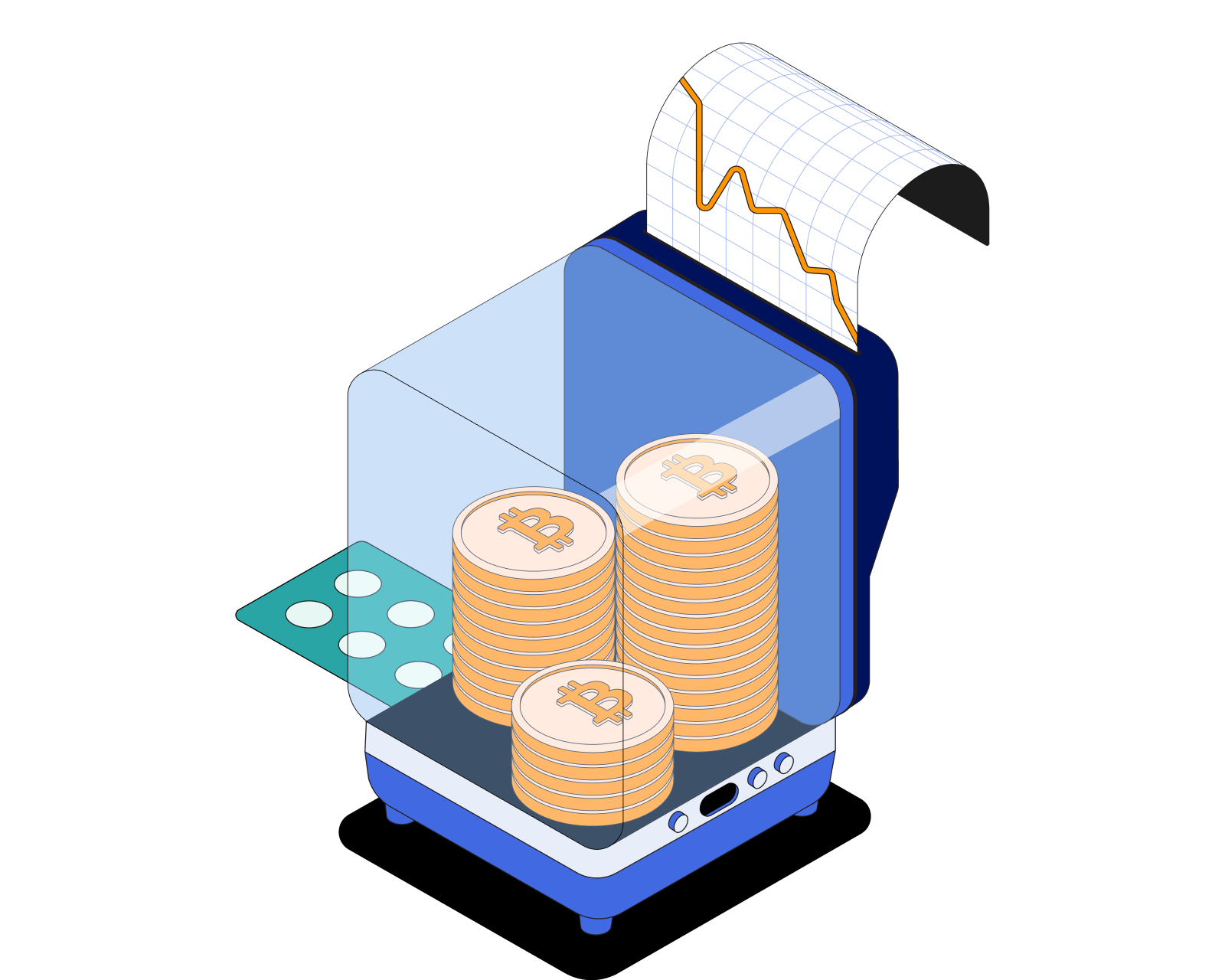스테이킹이란 무엇인가요?

암호화폐 스테이킹의 역사
스테이킹의 원래 정의는 블록체인 네트워크의 운영을 유지하는 과정을 설명합니다. 사람들은 지갑에 일정량의 블록체인 암호화폐를 보유하고 잠금함으로써 블록체인 네트워크에서 거래를 검증하는 데 참여합니다. 이를 대가로 보상을 받습니다. 시간이 지나면서 이 좁은 사용 사례는 사람들이 암호화폐나 디지털 자산을 잠그고 시간이 지남에 따라 보상을 받는 것을 설명하는 보다 일반적인 정의로 확대되었습니다.
암호화폐 스테이킹은 비트코인이 도입한 원래 합의 메커니즘인 작업 증명(PoW)이 직면한 문제에 대한 응답으로 발전했습니다. 스테이킹 개념으로 이어진 역사적 발전 과정을 살펴보겠습니다.
작업 증명과 그 과제들
암호화폐의 개념은 사토시 나카모토라는 이름의 ��개체(또는 개인)에 의해 처음으로 비트코인에 의해 실현되었습니다. 비트코인 네트워크는 거래를 검증하고 블록체인에 새 블록을 추가하기 위해 작업 증명(PoW)이라는 합의 메커니즘에 의존합니다. PoW에서는 채굴자들이 복잡한 수학적 문제를 해결하기 위해 서로 경쟁하며, 문제를 가장 먼저 해결한 사람이 블록체인에 다음 블록을 추가할 기회를 얻고 비트코인으로 보상을 받습니다.
그러나 PoW에는 여러 가지 문제가 있습니다. 퍼즐을 해결하기 위해 많은 컴퓨팅 파워가 필요하므로 에너지 집약적입니다. 또한 PoW는 초당 많은 거래를 처리할 수 없어 네트워크의 처리량이 제한됩니다.
지분 증명의 도입
이러한 문제에 대응하여 새로운 합의 메커니즘인 지분 증명(PoS)이 제안되었습니다. 이 아이디어는 QuantumMechanic이라는 사용자가 2011년 비트코인토크 포럼 게시물에서 처음 소개했습니다.
PoW와 달리 PoS는 블록체인에 새 블록을 추가할 검증자를 그들이 보유하고 스테이킹할 의향이 있는 코인의 수를 기반으로 선택합니다. 이는 결정 요인으로서의 컴퓨팅 파워의 필요성을 제거하여 에너지 집약성을 줄이고 잠재적으로 더 분산화될 수 있게 합니다.
스테이킹의 진화
PoS를 처음 구현한 암호화폐는 2012년에 출시된 Peercoin이었습니다. Peercoin의 혁신은 새로운 코인을 발행하기 위해 PoS를 사용하는 것이었고, 거래 처리를 위해 사용된 PoW 메커니즘을 보완했습니다. 이 하이브리드 시스템은 PoW의 보안성과 PoS의 에너지 효율성 사이의 균형을 맞추는 것을 목표로 했습니다.
스테이킹의 개념은 2014년 이더리움이 이더리움 2.0 업그레이드, 즉 세레니티를 통해 PoW에서 PoS로 전환할 계획을 발표하면서 발전했습니다. 이는 이더리움이 가장 큰 암호화폐 프로젝트 중 하나이기 때문에 스테이킹 개념을 주목하게 했습니다.
Tezos, Cardano 및 Polkadot과 같은 다른 블록체인도 PoS를 채택하여 스테이킹의 아이디어를 더욱 대중화했습니다. 이러한 프로젝트는 또한 스테이킹 파워를 검증자에게 위임할 수 있는 개념을 도입하여 기술적 지식이나 많은 양의 암호화폐 없이도 일반 사용자가 스테이킹에 참여할 수 있도록 했습니다.
현대의 스테이킹 관행
오늘날 스테이킹은 암호화폐 산업의 주요 부분이 되었습니다. 중앙화된 암호화폐 거래소조차도 사용자에게 중앙화된 스테이킹 서비스를 제공하고 있으며, 이는 스테이킹이 처음 만들어진 이유인 탈중앙화된 본질을 훼손하는 것으로 보입니다. 또한 스테이킹은 네트워크를 보호하고, 거래를 검증하며, 거버넌스 결정에 투표하고, 신생 프로젝트를 지원하는 데 사용되는 디파이(DeFi) 프로토콜의 필수적인 부분이 되었습니다.
사람들이 암호화폐를 스테이킹하는 이유는 무엇인가요?
- 수동 수입: 스테이킹은 암호화폐 보유자가 수동 수입을 얻는 방법을 제공합니다. 단순히 암호화 자산을 보유하고 스테이킹함으로써 참가자는 은행 계좌의 이자를 얻는 것과 유사한 스테이킹 보상을 받을 수 있습니다.
- 보안 강화: PoS 블록체인의 경우 더 많은 코인이 스테이킹될수록 네트워크의 보안이 강화됩니다. 스테이킹은 악의적인 활동이 전체 스테이킹된 토큰의 대다수를 제어해야 하는 추가 보안 계층을 네트워크에 추가합니다 - 이는 비용이 많이 드는 작업입니다.
- 네트워크 또는 프로토콜에 대한 영향력: 일부 암호화 자산은 토큰을 스테이킹하는 사용자가 네트워크 또는 프로토콜의 거버넌스에 발언권을 갖도록 허용합니다. 여기에는 프로젝트에 대한 업데이트 또는 변경에 대한 제안에 대한 투표가 포함됩니다. 사용자가 스테이킹하는 토큰이 많을수록 더 많은 투표 권한을 가집니다. 예를 들어, 투표자는 스테이킹 보상률을 결정하는 데 도움을 줄 수 있습니다.
- 프로젝트 지원 육성: 사람들이 토큰을 잠글 때, 그들은 프로젝트에 대한 풀뿌리 지원을 제공하고 있습니다. 그들은 토큰과 프로젝트에 대한 신뢰를 보여줍니다. 스테이킹된 토큰의 양은 커뮤니티 지원을 측정하는 데 개인 및 기업이 사용할 수 있는 공개적으로 이용 가능한 메트릭입니다. 커뮤니티 지원이 많은 프로젝트는 종종 더 많은 관심과 투자를 끌어들입니다.
유동적 스테이킹 토큰이란 무엇인가요?
유동적 스테이킹은 스테이킹의 주요 단점 중 하나인 스테이킹된 자산의 유동성 부족을 해결하려는 암호화폐 세계의 비교적 새로운 발전입니다.
사용자가 PoS 네트워크에서 암호화폐를 스테이킹할 때, 스테이킹된 자산은 종종 일정 기간 동안 스마트 계약에 잠겨 있으며, 이 기간 동안 자산을 판매하거나 거래할 수 없습니다. 이는 특히 변동성이 큰 시장 상황에서 스테이커에게 불편할 수 있습니다.
유동적 스테이킹은 스테이킹된 자산의 소유권을 나타내는 토큰, 종종 스테이킹 파생상품 또는 유동적 스테이킹 토큰이라고 불리는 토큰을 발행하여 이 문제를 해결합니다. 이러한 토큰은 자유롭게 거래, 판매 또는 다른 디파이 애플리케이션에서 담보로 사용할 수 있으며, 기본 자산은 네트워크에 스테이킹된 상태로 남아 있습니다.
다음은 프로세스가 일반적으로 작동하는 방식에 대한 기본 개요입니다:
- 사용자는 유동적 스테이킹을 지원하는 스테이킹 프로토콜에 암호화폐를 스테이킹합니다.
- 그 대가로 프로토콜은 이에 상응하는 양의 유동적 스테이킹 토큰을 발행합니다. 이러한 토큰이 발행되는 비율은 일반적으로 스테이킹된 자산의 가치를 반영합니다.
- 이러한 토큰은 사용자의 스테이킹된 자산 및 스테이킹으로부터의 잠재적 보상을 나타냅니다. 이들은 자유롭게 거래되거나 다른 디파이 프로토콜에서 사용되어 사용자에게 유동성을 제공합니다.
- 사용자가 스테이킹된 자산을 상환하고자 할 경우, 유동적 스테이킹 토큰을 프로토콜에 반환하면 프로토콜은 스테이킹된 자산 및 스테이킹 보상을 해제합니다.
Lido와 같은 플랫폼은 이더리움 2.0에 대한 유동적 스테이킹 서비스를 제공하고 있으며, Stafi는 스테이킹 파생상품을 위한 전용 플랫폼입니다.
암호화폐 스테이킹의 장점과 단점
스테이킹은 여러 가지 뚜렷한 장점을 제공하지만, 단점도 있습니다. 다음은 고려해야 할 주요 사항입니다.
암호화폐 스테이킹의 장점
- 수동 수입: 스테이킹의 주요 장점 중 하나는 지속적인 수동 수입을 창출할 수 있다는 것입니다. 코인을 보유하고 스테이킹함으로써 사용자는 은행의 예금 이자처럼 보상을 받을 수 있습니다.
- 에너지 효율성: 스테이킹은 많은 컴퓨팅 파워와 에너지 소비가 필요한 채굴보다 훨씬 에너지 효율적입니다. 반면, 스테이킹은 안정적인 인터넷 연결과 몇 개의 스테이킹된 코인만 필요합니다.
- 보안 강화: 지분 증명 시스템에서는 더 많은 코인이 스테이킹될수록 네트워크의 보안이 강화됩니다. 이는 네트워크에 대한 공격이 전체 스테이킹된 코인의 대다수를 요구하기 때문에 비용이 많이 들기 때문입니다.
- 거버넌스 참여: 일부 블록체인에서는 스테이킹이 사용자가 네트워크의 거버넌스에 참여할 권리를 제공합니다. 여기에는 네트워크 프로토콜이나 규칙에 대한 제안된 변경 사항에 대한 투표가 포함될 수 있습니다.
- 잠금 기간: 많은 스테이킹 프로그램은 사용자가 일정 기간 동안 코인을 잠그도록 요구합니다. 이 기간 동안 스테이킹된 코인은 판매하거나 거래할 수 없으며, 이는 시장 가격이 불리하게 변할 경우 단점이 될 수 있습니다.
암호화폐 스테이킹의 단점
- 손실 위험: 네트워크가 손상되거나 스테이킹 풀이 잘못 관리될 경우, 사용자는 스테이킹한 모든 코인을 잃을 수 있습니다.
- 슬래싱: 일부 스테이킹 시스템에서는 검증자 노드가 오프라인되거나 올바르게 검증하지 못할 경우, 스테이킹된 코인의 일부(검증자의 자체 코인과 위임된 코인 모두)가 "슬래싱"되거나 벌칙으로 몰수될 수 있습니다.
- 인플레이션: 스테이킹 보상은 매력적인 수입을 제공할 수 있지만, 또한 유통 중인 코인의 공급을 증가시킵니다. 이는 잠재적으로 인플레이션을 초래하여 시간이 지남에 따라 코인의 가치를 떨어뜨릴 수 있습니다.
- 복잡성: 일부 사용자에게는 스테이킹의 복잡성이 저해 요인이 될 수 있습니다. 일부 스테이킹 방법은 상당한 기술 지식을 요구하며, 기술적으로 덜 숙련된 사용자에게는 접근하기 어려울 수 있습니다.
암호화폐 스테이킹 방법
스테이킹 프로세스는 각 프로젝트에 따라 다를 수 있지만, 일반적인 단계는 다음과 같습니다:
- 토큰 획득: 스테이킹하려는 프로젝트를 식별하고 해당 프로젝트에 적합한 토큰을 구매하거나 교환합니다. 토큰은 가능�한 한 Bitcoin.com Wallet 앱과 같은 셀프 커스터디 지갑에 넣어야 합니다.
- 토큰 스테이킹: 프로젝트의 스테이킹 방법을 따릅니다. 일반적으로 "스테이킹" 버튼을 클릭하는 것처럼 간단한 인터페이스가 있을 것입니다.
- 보상 받기: 토큰 스테이킹을 시작한 후에는 보상을 기다리기만 하면 됩니다. 이러한 보상의 빈도와 크기는 스테이킹하는 토큰의 수와 네트워크의 전체 스테이킹 비율 등 여러 요인에 따라 달라질 수 있습니다.
아래 동영상에서 Bitcoin.com Wallet 앱을 사용하여 VERSE 토큰을 스테이킹하는 방법에 대한 구체적인 예를 배울 수 있습니다. VERSE 스테이킹에 대해 모두 알아보려면 여기를 참조하십시오.
관련 가이드
여기에서 시작 →

토큰이란 무엇인가요?
토큰이 무엇인지 그리고 암호화폐와 어떻게 다른지 알아보세요.


APY란 무엇인가요?
APY는 연간 수익률을 의미합니다. 이는 복리 이자의 효과를 포함하여 투자에서 얻은 이자를 계산하는 방법입니다.

유동성이란 무엇인가요?
유동성은 약간 다르지만 상호 관련된 여러 의미를 가지고 있습니다. 암호화폐의 목적에서는 유동성이 주로 금융 유동성과 시장 유동성을 의미합니다.
이 기사 읽기 →
유동성이란 무엇인가요?
유동성은 약간 다르지만 상호 관련된 여러 의미를 가지고 있습니다. 암호화폐의 목적에서는 유동성이 주로 금융 유동성과 시장 유동성을 의미합니다.


유동성 풀은 무엇인가요?
유동성 풀은 스왑, 대출 및 수익 획득과 같은 더 효율적인 금융 거래를 촉진하는 데 도움을 주는 암호화 자산의 모음입니다.
암호화폐에서 앞서 나가세요
우리의 주간 뉴스레터로 가장 중요한 통찰력을 제공받아 암호화폐에서 앞서 나가세요.
매주 당신을 위한 암호화폐 뉴스 큐레이션
실행 가능한 인사이트와 교육적인 팁
경제적 자유를 촉진하는 제품에 대한 업데이트
스팸 없음. 언제든지 구독 취소 가능합니다.






